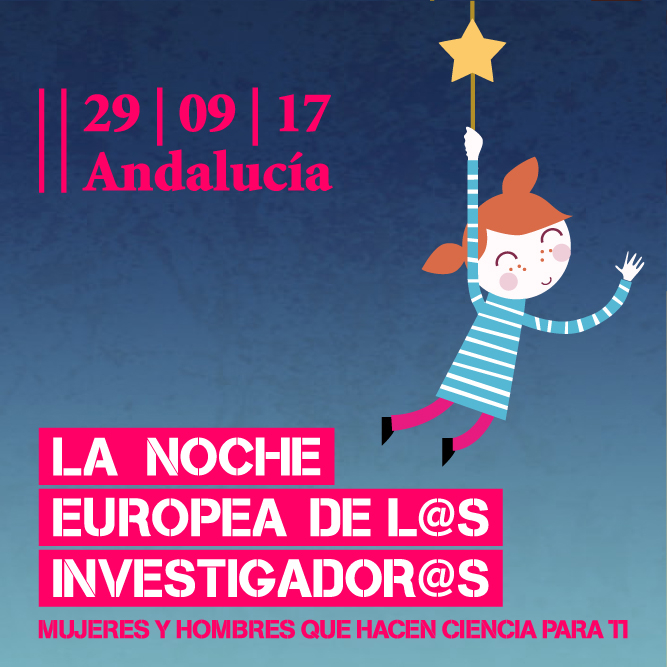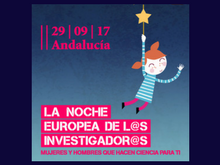Seville, 18 September 2017. Once again, researchers from cicCartuja will participate in the European Researchers’ Night, an initiative promoted by the European Commission within the framework of the Horizon 2020 programme. This scientific dissemination event will take place simultaneously in more than two hundred and fifty cities in Europe on 29 September.
In Seville, the Spanish National Research Council (CSIC), the University of Seville (US), the Pablo de Olavide University (UPO) and the City Council of Seville, among other institutions, have joined forces to offer a programme made up of workshops, micro-meetings and shows. The aim is to foster a rapprochement between citizens and the scientific community in a relaxed atmosphere and through informative and practical language.
The unique format of this initiative allows citizens to learn more about the work carried out by researchers and to overcome some of the stereotypes that weigh on them. Researchers, for their part, are given the opportunity to demonstrate that they do not live in isolation from the reality outside their laboratories.
The micro-meetings in which the researchers will participate will be structured around a talk where various concepts will be introduced and discussed with the public, using examples of recent research.
Below are more details about these micro-meetings that the cicCartuja researchers will offer:
What kind of world would we live in without catalysts?
Jesús Campos Manzano (IIQ)
Location: European Corner, Plaza Nueva, Seville
Time: 8:00 p.m.-9:00 p.m.
Summary of the activity: the concept of catalysis will be presented in an informative way: what it is, what catalysts are and why they are so important in our daily lives. Currently, the speaker is carrying out his research work around this project, associated with a Marie Curie grant and financed with European funds.
Photonic crystals, nanotechnological materials for light control
Mauricio Calvo Roggiani and Miguel Anaya Martín (ICMS)
Location: Tent 2 / US, CSIC, UPO, Plaza Nueva, Seville
Time: 10:00 p.m.-11:00 p.m.
Summary of the activity: photonic crystals were theoretically proposed at the end of the last century. However, using the most powerful experimental techniques, it is now possible to manufacture them and study their properties. In this talk we will not only explain the theoretical proposal for this type of materials, but we will also exemplify their most relevant uses, in applications as diverse as solar cells, information technologies, radiation protection, etc. We will also show in a simple way how these materials are manufactured in the laboratory and what examples of their use we find and will find in our daily lives. Finally, we will present the most relevant results obtained by the speakers’ research group in this field.
Nanomaterials, much more than miniaturization
Juan Ramón Sánchez Valencia (ICMS)
Location: Carpa 5 / CSIC. Plaza Nueva, Seville
Time: 19.00-20.00 h
Summary of the activity: Nanomaterials are considered to be those in which at least one dimension is in the nanometer range. A nanometer is one billionth of a meter, about a million times smaller than a mosquito. When materials are in the nanoscale, they have unique properties. Nanotechnology is dedicated to the prediction, study and use of these unique characteristics, which can modify mechanical, electrical or optical properties, among many others. This micro-meeting will revolve around this topic and one of the future goals of nanotechnology: the integration of nanodevices in systems capable of generating electricity and performing intelligent tasks, such as responding to external stimuli, acting, communicating and controlling responses.
Graphene nanoplatelets: when size matters
Rosalía Poyato Galán (ICMS)
Location: Carpa 5 / CSIC. Plaza Nueva, Seville
Time: 10:00 p.m.-11:00 p.m.
Summary of the activity: Graphene is one of the allotropes of carbon, that is, it can be presented in a different form, giving rise to elements such as graphite or diamond. Graphene was first synthesized in a laboratory by Geim and Novoselov in 2004 and, since then, it has aroused great interest in the scientific world, due to its exceptional mechanical and thermal properties. The incorporation of graphene into ceramic materials is currently a widely researched field, as this leads to significant improvements in the properties of the ceramic compounds obtained.
More information on the official website of the event




